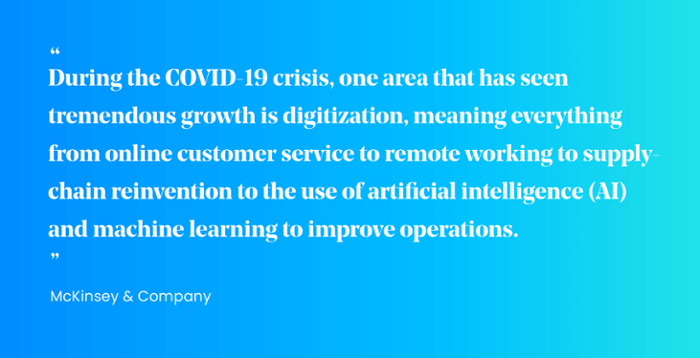
Will a low-touch and digital-first service focused digital transformation strategy still be important after COIVD-19? Yes, your remote customer experience (CX) strategy is more important than ever.
This series highlights the different teams and stakeholders you’ll need to engage in your digital transformation strategy and the ways in which those teams will need to adapt and collaborate in order to deliver results with a remote customer mindset.
- Read: What Customer-first Digital Transformation Looks Like in 2021
- Download: Remote Innovation Mindset eBook
Research (McKinsey, Accenture, below) shows that successful digital transformation strategy is a primary focus for the enterprise in 2021—especially as the COVID19 pandemic disrupted supply chain and business continuity across all sectors and industries.

Major brands are committed to investing in the digital strategies that help them reach more customers, service those customers more effectively with the personalized service digital natives expect, and measure and scale the impact of the new operational efficiencies these programs deliver.
Executives must lead the charge—challenging teams to reimagine their customers’ journey and how they should adapt to more responsively meet customers on their own time and on their channel of choice.
Re-organize for digital transformation Strategy
A customer-first digital transformation strategy requires that teams review their KPIs, their processes, and their analytics to ensure that they truly align to a customer’s journey and expectations.
While cross-functional alignment and collaboration is key to any enterprise initiative, visionary executive leadership and C-suite support are the key indicators for digital transformation program success. Without an overt executive mandate and sustained leadership to reorganize around the customer, transformation efforts can slip back into unproductive “business as usual” all too quickly.
Prioritize customer experience data
Great CX and digital transformation strategy both rely on a clear understanding of what makes a difference for a customer. In nearly every transformation program, outdated enterprise systems silo data and block the real-time end-to-end insights needed to deliver on CX goals.
Transformation will not progress until you can measure how well you deliver on what matters to customers. Executives must advocate for end-to-end omnichannel reporting and may need to sponsor back-end tools and process changes to see the results they expect.
The good news is that the costs of cleaning and activating your CX data far outweigh the risks of NOT measuring your work at all. And, these operational investments, like migrating to integrated cloud platforms, often have a quick rate of return and broad organizational impact.
640inline.jpg)
Build omnichannel customer relationships
Customers just spent a year re-learning how to complete their daily tasks in new low-touch and remote ways—they’re not going back.
Instead of returning brick and mortar locations as the center of brand experiences, innovative executives are taking a page from the direct-to-consumer (DTC) playbook developing digital customer relationships, prioritizing real-time responsive customer service, and turning great experiences into brand advocacy with an end-to-end focus on customer success.

Create ROI from responsive customer service
Today’s digital, always-on customers place a high value on responsive customer service and real-time resolutions. They do not hesitate to try new brands when experiences fail to meet expectations.
A responsive service model can quickly transform Enterprise Support operations from a cost center into a revenue engine by significantly boosting customer satisfaction while driving down the overall cost per-resolution.
For Traeger Grills moving to a responsive customer service model raised customer satisfaction scores to above 90 and reduced their yearly warranty spend by 51% in the first year. Learn more about Traegers’s responsive customer service model.

Everyone wins when Executives champion CX
The work to transform traditional business models into the dynamic connected experiences customers expect, and deserve, takes leadership buy-in and cross-team support at every step of the process.
Executives must show leadership in digital transformation initiatives, prioritizing remote CX data, and building the always-on, omnichannel capabilities that allow for responsive customer service. With these crucial organizational capabilities in place, enterprise teams can realize the promise of digital transformation and customer win at every-step of the way.

Footnotes
- How COVID-19 has pushed companies over the technology tipping point—and transformed business forever https://www.mckinsey.com/business-functions/strategy-and-corporate-finance/our-insights/how-covid-19-has-pushed-companiesover-the-technology-tipping-point-and-transformed-business-forever
- An Experience Renaissance to Reignite Growth https://www.accenture.com/us-en/insights/interactive/business-of-experience
- The next normal arrives: Trends that will define 2021—and beyond https://www.mckinsey.com/featured-insights/leadership/the-next-normal-arrives-trends-that-will-define-2021-and-beyond
